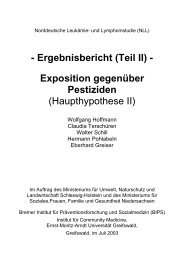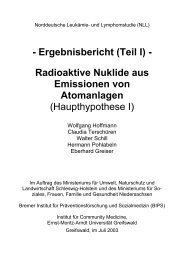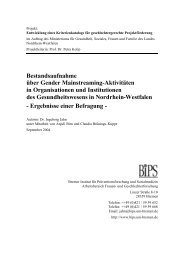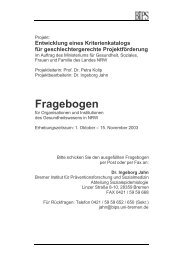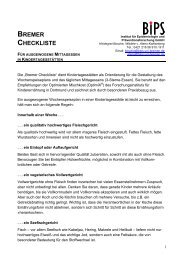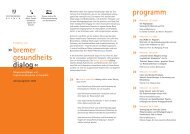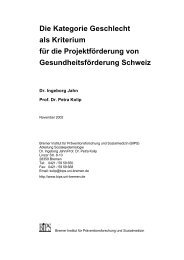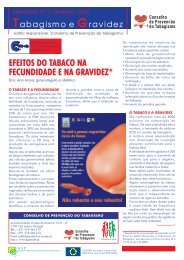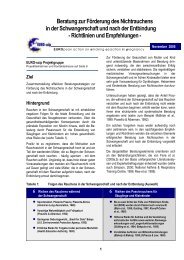Create successful ePaper yourself
Turn your PDF publications into a flip-book with our unique Google optimized e-Paper software.
Euroscip <strong>III</strong><br />
Ireland Smoking Cessation Report<br />
National Status Report<br />
Audrey Deane Wannagat<br />
Edited by Marian Flannery<br />
Women of the North West Ltd.,<br />
MoygownaghCommunity Cemtre<br />
Moygownagh<br />
Ballina<br />
Co Mayo
Table of Contents<br />
Context 3<br />
Legislation 3<br />
Statistics 4<br />
National smoking statistics 5<br />
Health behaviour statistics 5<br />
Smoking cessation policy 6<br />
Smoking cessation research 6<br />
Trends in Smoking cessation practice 7<br />
Smoking Cessation Officers<br />
Data deficits 8<br />
Motivational training , DVD’s and 9 - 10<br />
Newsletters<br />
Survey Report 11 - 18<br />
Conclusion 19 - 20<br />
References 21<br />
2
Context<br />
This report sets out to describe the policy and legislation pertinent to the<br />
issue of smoking cessation and pregnancy in Ireland. It gives, where<br />
possible, relevant statistics, maps relevant health policy and legislation and<br />
seeks to describe both good practice smoking cessation interventions - where<br />
accessible - and relevant research.<br />
Draft findings are as follows:<br />
o There is much agreement between policy makers and the various<br />
players that there is a serious deficit in smoking statistics related to<br />
women. There are no statistics available on smoking rates in pregnant<br />
women whether smokers or non smokers.<br />
o Evidence for smoking cessation is weak with no centrally collated<br />
statistics.<br />
o There is a high level of compliance with the recently introduced<br />
smoking ban in the workplace which has resulted in 96% of workplaces<br />
being smoke free.<br />
o The structural reforms within the health services in Ireland will impact<br />
on how smoking cessation services are and will be delivered in the<br />
future.<br />
o Smoking cessation practice is currently delivered in an adhoc and<br />
unmonitored manner with no national guidelines or centrally collated<br />
statistics.<br />
Legislation<br />
On March 29 th 2004 it became illegal to smoke in enclosed working<br />
environments under the Public Health (Tobacco) Acts 2002 and 2004 in the<br />
Republic of Ireland.<br />
This means that it is illegal to smoke in public buildings, pubs, on all types of<br />
public transport, factories, shops, restaurants, hotels, hospitals and offices.<br />
There are some exceptions for example psychiatric hospitals.<br />
A year on from the introduction of the smoking ban in the workplace a report<br />
from the Office for Tobacco Control found the following:<br />
� Compliance with the smoke free legislation is very high<br />
� 94% of all workplaces inspected under the National Tobacco Control<br />
Inspection Programme were smoke-free<br />
3
� 96% of all indoor workers report working in smoke-free environments<br />
since the introduction of the ban<br />
� Air quality in pubs has improved dramatically since the ban<br />
� Levels of carbon monoxide have decreased by 45% in non-smoking<br />
bar workers<br />
� 96% of all indoor workers report working in smoke-free environments<br />
since the ban was introduced<br />
� 98% of people believe that workplaces are healthier<br />
� 96% of people feel that the smoke-free law is a success 1 including<br />
It is interesting to note that under this legislation domestic homes are not<br />
counted as work places. As Ireland continues to have lower numbers, in<br />
comparison with other EU and OECD countries, of women working outside the<br />
home it is possible to assert that many women live in homes were they are<br />
exposed to ETS (exhaled tobacco smoke). Given that ETC is a known<br />
carcinogenic and is a causal factor in low birth weight babies’ 2 research<br />
should be conducted to ascertain the risk to women in the home of ETS.<br />
Statistics<br />
Robust statistics on smoking cessation and pregnancy are not available in<br />
Ireland. Regrettably there is also a data deficit on smoking and pregnancy.<br />
However, we do know that in relation to Ireland it can be argued that there is<br />
a very steep social gradient wherein people from the lower socio-economic<br />
groups experience much worse health status, life expectancy and morbidity.<br />
The smoking related data cited previously also displays a clear socio-economic<br />
gradient with poorer people smoking more.<br />
The following piece of research conducted in Mayo on the west coast of<br />
Ireland by Women of the North West (Moygownagh Community Development<br />
Project), the Irish partner in the European EIRO - SCIP Project 111, gives<br />
evidence of the relevance of including the social determinants when engaging<br />
in health service planning and design. There is a clear correlation between<br />
smoking and low educational attainment with the greatest number of the<br />
interviewed women (80) at the centre of the Irish research having spent less<br />
than eleven years or more in formal education.<br />
It is also necessary to note that those surveyed for purposes of this research<br />
were public hospital patients and more likely not to have private health<br />
insurance for economic reasons. This bears out previous research which<br />
shows a clear link between level of income and smoking prevalence,<br />
particularly for young women.<br />
1 Smoke-Free Workplaces in Ireland: A One Year Review. Office for Tobacco Control. 2005. A<br />
nationally representative sample of 1000 people aged over fifteen years was used in the<br />
report.<br />
2 Babies born with a weight of 2000 grammes or less.<br />
4
National smoking statistics<br />
The Office for Tobacco Control (OTC) collates and analyses smoking statistics<br />
on a monthly basis. The information comes from a collection of a 1,000<br />
responses a month from people over fifteen years of age. A quota sample of<br />
1,000 people aged over fifteen years and weighted by gender, age, social<br />
class and region. The most recent statistics from January 2006 indicate the<br />
following:<br />
• Overall prevalence of cigarette smoking is 23.9%<br />
• 50.1% of smokers are female, 49.8% are men<br />
• smoking prevalence is highest in the skilled working class C2<br />
• Almost 32% of people in the 19 – 35 age group classified as smokers<br />
• Smoking rates are highest in Dublin 3<br />
Unfortunately the OTC does not capture any statistics on pregnant women<br />
who smoke.<br />
Health behaviour statistics<br />
The SLAN survey is the only longitudinal study on lifestyles, attitudes and<br />
nutrition to be carried out in Ireland. It is conducted by the Centre for Health<br />
Promotion Studies in the National University of Galway. It has been<br />
conducted twice to date, in 2000 and 2002. The next set of results are due in<br />
2007. SLAN does not yield smoking and pregnancy related statistics, but it<br />
does however give socio economic information on smokers. To date it has<br />
given interesting statistics on smoking behaviours with a clear social economic<br />
gradient wherein people from lower social classes smoke more, in particular<br />
women. The 2002 Slan survey gave the following statistics:<br />
o 33% of women aged 18 – 34 years smoked<br />
o 25% of women 35 to 54 years smoked<br />
o 32% of girls aged 15 to 17 years in Social Classes 3 – 4 smoked<br />
o 36% of girls aged 15 to 17 years in Social Classes 5 – 6 smoked<br />
SLAN does not capture pregnancy related statistics.<br />
The <strong>BIPS</strong> survey concerning smoking and pregnancy conducted in the wider<br />
western region has produced a clear connection between social class and<br />
smoking behaviour. This is particularly apparent in relation to the prevalence<br />
of smoking in pregnancy and low educational attainment. Only 23.50% of<br />
those women surveyed had spent enough time in formal education achieve<br />
the completion of upper secondary level. Moreover, the Slan report makes the<br />
3 Ireland: Current trends in cigarette smoking. Office for Tobacco Control. 2006.<br />
5
argument that young women in the ages from 15-17 form the biggest<br />
tobacco consumer grouping resulting in the figure of 36%.<br />
When one considers that the average age of those women survey in the <strong>BIPS</strong><br />
survey was 29 years. With a combination of lower social class and low<br />
educational achievement it can be argued that future studies conducted show<br />
that smoking rates in pregnancy have increased. In the absence of<br />
educational smoking prevention targeting of such social groupings the<br />
prevalence of smoking and pregnancy will increase. Presently the reality is<br />
that the non- segregtion of smoking and pregnancy prevalence ensures that<br />
the national statistics for Ireland appear less. This report makes the<br />
argument that it is only when a closer examination of smoking prevalence and<br />
pregnancy is targeted at specific social groupings that we can come to<br />
identify where there is policy practice failures in the health promotion system.<br />
The Chairperson of the OTC publicly stated that “there needs to be a<br />
concerted and focussed effort by all those interested in women’s health to<br />
develop effective smoking cessation programmes specifically for women”.<br />
Smoking cessation policy<br />
As stated in the 2003 report there are a raft of health strategies in which<br />
smoking cessation is cited as a priority. These strategies include Quality and<br />
Fairness - a health system for you (Irish Health Strategy), Primary Care – a<br />
new direction, the Cardiovascular Health Strategy and the National Health<br />
Promotion Strategy. There will be a third progress report from the<br />
Cardiovascular Strategy due out in 2006 which will give up to date<br />
information on smoking cessation.<br />
There is no shortage of public pronouncements on the challenges facing<br />
smoking cessation policy particularly in relation to the numbers of women<br />
who smoke.<br />
The Director of the National Cancer Registry has stated that in light of the<br />
high numbers of women smokers who wish to quit but find it difficult that “we<br />
owe it to these women to give them the right type of help, and support them<br />
when they need it”. The fact that lung cancer will be a predominantly female<br />
disease by 2020 due to the increasing rates of women sufferers is seen as<br />
cause for concern.<br />
Smoking cessation research<br />
As there is no central database collating relevant health information it is not<br />
possible to definitively comment on the current level of research into smoking<br />
cessation and pregnancy.<br />
6
A major research study currently ongoing, a partnership between the Rotunda<br />
Maternity Hospital in Dublin and the Public Health Department of the Health<br />
Services Executive, is expected to have a positive impact on the numbers of<br />
women who smoke through out pregnancy. The following paragraphs<br />
describe the research.<br />
The objective of this research is to establish the effectiveness of motivational<br />
interviewing of pregnant smokers and to reduce the numbers of smoking<br />
mothers to be with a view to becoming standard practice across all maternity<br />
hospitals and units. It is jointly funded by the Irish Heart Foundation and the<br />
Health Service Executive.<br />
It covers the geographic catchment area of the Rotunda hospital. At its core<br />
is the training in motivational interviewing of all relevant hospital staff who<br />
come in contact with smoking pregnant women. Staffs trained to date are all<br />
nurses and midwives, administrative staff, Public Health Nurses (PHNs), Out<br />
Patient Department nurses.<br />
The study began in 2004 with the recruitment, with informed consent, of 500<br />
pregnant smokers who act as the control group. The cases for the study are<br />
now being recruited with 350 involved to date. These cases are offered<br />
ongoing motivational training at each hospital visit beginning with their first<br />
visit to the hospital. They are also given a card to contact the Smoking<br />
Cessation Officers who work in a variety of community settings. In all there<br />
are five opportunities to deliver and repeat the motivational training:<br />
� At the first booking visit<br />
� At 28 and 32 weeks of pregnancy<br />
� The hospital stay for the birth<br />
� At the three month infant developmental visit carried out by a Pubic<br />
Health Nurse<br />
A positive aspect of this ongoing research is that the hospital has included the<br />
delivery of the motivational training as part of its training programme for<br />
student midwives.<br />
An evaluation is planned in the short term which will examine the perceptions<br />
and attitudes of those delivering the training to establish their attitude<br />
towards the training. Modifications to the training will be made if necessary.<br />
Trends in Smoking cessation practice<br />
Smoking Cessation Officers – the key workers<br />
A recommendation from the Cardiovascular Strategy, published in 1999, was<br />
that a Smoking Cessation Officer (SCO) be appointed in each Community Care<br />
7
Area. Community Care Areas are the geographic catchment areas within the<br />
Health Services Executive. This smoking cessation staffs are all based in<br />
regional Health Promotion Departments of the Health Services Executive and<br />
their brief covers:<br />
� policy development<br />
� delivery of smoking cessation programmes<br />
� training of health care professionals<br />
The recruitment of Smoking Cessation Officers has occurred in an adhoc<br />
manner across the country with numbers of officers varying across regions.<br />
There has also been a public service embargo on staff recruitment which has<br />
hindered staffing levels. It is sometimes the case that Smoking Cessation<br />
Officers hold other functions within Health Promotion Units so that not all of<br />
their time is dedicated solely to smoking cessation related activities.<br />
Therefore it is difficult to know at any one time how many smoking cessation<br />
staff are active. As the post holders sometimes have a range of objectives it<br />
is difficult to capture, monitor and evaluate their work load, outputs and most<br />
importantly the effectiveness of their outcomes. This management<br />
information weakness has an obvious impact on strategic resource planning<br />
for smoking cessation at national level.<br />
National Smoking Cessation Guidelines for these smoking cessation staff have<br />
been drawn up but await implementation. The publication of these guidelines<br />
would create cohesion and focus for smoking cessation officers and aid<br />
uniformity of service delivery. There would be an obvious knock on effect for<br />
the reliability and utility of the data and information captured from their work<br />
if it was all captured in the same way.<br />
Data Deficits<br />
It had been envisaged that detail regarding the activities and outcomes of all<br />
the Smoking Cessation officers working with pregnant and mothers who have<br />
given birth in maternity units in Ireland would be available for this report.<br />
Unfortunately due to resources constraints within the HSE this useful<br />
information is unavailable at time of writing. It is known however, that there<br />
are about twenty Smoking cessation staffs working within maternity settings<br />
in Ireland. A seminar is planned for later this year which these officers will<br />
attend and data regarding their outputs and outcomes is currently being<br />
compiled, as mentioned. This seminar is being organised by a senior smoking<br />
cessation officer based in Dublin who also carries a brief as the part time coordinator<br />
of the Irish Smoke Free Hospitals Initiative (a member of the<br />
European Network of Smoke Free Hospitals Initiative) At this point in time it<br />
appears that there is a growing political will to engage other actors as a<br />
means of ensuring that a more specific targeting of research and education<br />
should be happening regarding the growing concern of smoking and<br />
pregnancy prevalence.<br />
8
Motivational Training<br />
Relevant information was requested from these SCOs at national level in<br />
relation to the training they provide, its content, target groups and what<br />
perceptual and attitudinal barriers they encounter in their work.<br />
All smoking cessation officers use motivational interviewing (MI) and the cycle<br />
of change methodologies when delivery training either in either a group<br />
setting or on an individual basis. This type of training makes careful use of<br />
simple and appropriate language to provide people with an understanding of<br />
the complexities of smoking. MI is based on the following principles:<br />
� Expressing empathy: skilful reflective listening<br />
� Developing discrepancy: client presents arguments for change<br />
� Rolling with resistance: avoids arguing<br />
� Supporting self efficacy: client responsible for choosing/carrying out<br />
change 4<br />
The above approach is client centred yet is also a directive method to<br />
enhance intrinsic motivation to change by exploring and resolving<br />
ambivalence. The method, developed by William Miller and Stephan Rollnick,<br />
has been widely examined has proven outcomes as a method of substance<br />
abuse treatment.<br />
In the Health service Executive West region, some 278 professional staff has<br />
been trained. The target groups in the west region were nursing staff, social<br />
workers, occupational therapy health assistants, homecare personnel,<br />
physiotherapy and youth workers. In addition some 28 staff midwives also<br />
participated in the regional training programmes.<br />
The training was conducted over two days. It was facilitated by two health<br />
promotion officers operating with the Health Executive Service. At all times<br />
this motivational training is open to internal staff and personnel working in<br />
the voluntary sector.<br />
Aids to promote motivational training.<br />
DVD’s<br />
It is evident from the work of this project that there are problems in gaining<br />
access to health Service Executive staff for the purpose of delivering<br />
motivational training in smoking cessation methods. In fact the level of access<br />
4 Reproduced from the Smoking, Pregnancy and the Newborn training manual currently in<br />
use in the Rotunda study<br />
9
and co-operation experienced by the Smoking Cessation staff can only be<br />
described as frustrating. During the period and experience of this project we<br />
have encountered the cancellation of motivational training because of poor<br />
attendance. This has caused time delays and financial wastage. Therefore, it<br />
must be argued that the purchase of motivational material in the form of DVD<br />
or Training manuals for the purpose of supporting further motivational<br />
training within the Health Service Executive could very well be seen as a<br />
further waste of money given that there is no real evidence of a political will<br />
to seriously promote training and education of smoking cessation<br />
methodologies.<br />
Newsletters<br />
The promotion of written material (Newsletters) supporting the cessation of<br />
smoking in pregnancy must by its nature have only a limiting effect on an<br />
overall public and professional awareness. Moreover, there is a lack of<br />
support at national level necessary to do this work effectively. This<br />
organisation is very aware that the dissemination of the information contained<br />
in the newsletters produced as part of <strong>BIPS</strong> (111) is highly dependent on the<br />
professionals who hold power in the health care sector. However, and<br />
thankfully because of the organisations work with the Women’s Health<br />
Advisory Committee, West Regions, the particular connections to disseminate<br />
the newsletter directly to health professionals has been possible.<br />
10
EURO-scip <strong>III</strong> Survey Report – Ireland<br />
This research was conducted in the Health Service West area. This<br />
administrative health area covers the northwestern, mid western and western<br />
region of Ireland. The questionaire was administrated by Women of the<br />
North West (Moygownagh Community Development Project) located in<br />
Moygownagh Community Centre north of Ballina in County Mayo.<br />
The work of the project is closely linked with the women’s health activity of<br />
the project. The organisation WNW has a long association with women’s<br />
health activity. The association first began at the time of the Beijing United<br />
Nations Women’s Conference 1995. The tradition of gender specific health<br />
promotion connections between Women of the North West and Health<br />
Authorities has enabled this research. This is so because of a close working<br />
connection and co-operation between WNW and the health authorities both<br />
local and national is now well established. However, it must also be<br />
acknowledged that the actual collection of the data for this particualr was not<br />
easy. Furthermore, it must be also stated that gneral data on smoking in<br />
pregnancy in Ireland is not readily available. Neither is there overt evidence<br />
that pregnant women are a source of active anti smoking preventative<br />
measures within the healthcare sector. Cases of preventative measures<br />
appear to be of a pilot nature.<br />
It is against this background that the research aspect of the Irish Euro-scip<br />
111 project was conducted.<br />
The specific aim of this project work was to estimate smoking prevalence<br />
amongst pregnant women at different stages during their pregnancy. The<br />
objective being the creation and updating of a data base in eight countries,<br />
namely; Belgium, Bulgaria, Germany, greece, Ireland and Portugal. The Irish<br />
research site (Women of the North West) are anxious to acknowledge the<br />
assistance and support of the the offices of the HSE West Smoking<br />
Cessation, the Women’s Health Co-ordinator and the regional hospitals<br />
midwifery personnel.<br />
Methodology<br />
Initially, 300 GP’s were targetted throughout the Western area. This route<br />
was chosen because of the potential of access to a wide population of<br />
pregnant women given GP’s provide combined ante-natal care. The cooperation<br />
of the GP’s was sought with the aid of a letter of introduction.<br />
Stamped addressed envelopes were included with the questionaire and letter<br />
of introduction.<br />
By September of 2005 it was apparent that the response rate was slow and<br />
consequently low. Such a response was not adequate to secure 200<br />
completed questionaires.. Therefore, it was decided to engage the assistance<br />
of maternity hospital midwives and key hospital personnel engaged in antismoking<br />
motivational training. The strategy proved benefical to the collection<br />
of the data with just under 200 questionaires having been returned by late<br />
December 2005. However, attention must be drawn to the fact that reliance<br />
on this method of the data collection by the smoking pervention personnel<br />
11
in particular has resulted in an over representation of smokers amongst<br />
those pregnant women interviewed. Pregnant women smokers referred for<br />
smoking prevention were the group targetted at University College Hospital<br />
Galway.likewise those women interviewed by public maternity personnel are<br />
in the main more likely to be in direct contact with lower socio economic<br />
groupings of women.Account must be taken of the fact that in Ireland middle<br />
and upper class pregnant are most likely to avail of private maternity care.<br />
Results<br />
Question 1: Check if the woman is in the third trimester of<br />
pregnancy or after delivery at the maternity…<br />
The majority of those pregnant women interviewed were in the third trimester<br />
of pregnancy, the resulting percentage being 64%. Thirty six percent of the<br />
target group were interviewed after delivery.<br />
Table 1.<br />
Frequen<br />
cy %<br />
third trimester 128 64%<br />
maternity 72 36%<br />
Total 200 100%<br />
Question 2: When did you discover you were pregnant?<br />
Seventy-eight per cent of the women discovered they were pregnant in the<br />
first trimester of their pregnancy. Interestingly, the largest percentage<br />
(94.50%) acknowledged the discovery of their pregnancy after the first three<br />
months stage.<br />
12
Table 2.<br />
first trimester (1.-<br />
13.week)<br />
second trimester (14.-<br />
26.week)<br />
third trimester<br />
(>26.week)<br />
Frequen<br />
cy %<br />
13<br />
Cumulati<br />
ve<br />
Frequen<br />
cy<br />
156 78% 156 78%<br />
Cumulati<br />
ve<br />
%<br />
33 16.5% 189 94.5%<br />
11 5.5% 200 100%<br />
Question 3: Did you ever smoke?<br />
Table 3<br />
Frequency % Cumulative<br />
Frequency<br />
Cumulative<br />
%<br />
Yes 160 80% 160 80%<br />
No 40 20% 200 100%<br />
Response to question 3.<br />
Eighty percent (80%) of the women interviewed admitted to having smoked<br />
with a further 20% claiming non-smoker status.(Question 3.)<br />
Question 4: Are you an ex-smoker or present smoker?<br />
The further line of questioning to establish present smoking status resulted in<br />
the following;<br />
One percent declined to answer. Twenty seven percent (27%) claimed exsmoker<br />
status while a high of 52% were present smokers. A mere 20.0% of<br />
the women never smoked. This leaves an overall figure of 47% of the women<br />
in the no smoking during pregnancy category.
Table 4<br />
Smoking status (all)<br />
smoker<br />
Frequen<br />
cy %<br />
Cumulati<br />
ve<br />
Frequen<br />
cy<br />
No answer 2 1.0% 2 1%<br />
never<br />
smoking<br />
present<br />
smoker<br />
40 20% 42 21%<br />
104 52% 146 73%<br />
14<br />
Cumulati<br />
ve<br />
Percent<br />
ex-smoker 54 27% 200 100%<br />
Question 5: When did you quit smoking? (Ex-smokers only)<br />
A combination of the planning of the pregnancy and the confirmation of<br />
pregnancy caused the majority (77.8%) to cease smoking. Just over half of<br />
the interviewees had chosen to quit smoking prior to the pregnancy. A further<br />
breakdown of the figures tells us that 31.5% of the interviewed women quit<br />
smoking at the time they found out about their pregnancy. Just over f<br />
(22.2%) of the interviewees were motivated to stop smoking during the<br />
pregnancy.<br />
Table 5. Time of quitting smoking for present ex-smokers<br />
before you found out about this<br />
pregnancy<br />
at the time you found out about this<br />
pregnancy<br />
Frequen<br />
cy %<br />
Cumulat<br />
ive<br />
Frequen<br />
cy<br />
Cumulat<br />
ive<br />
%<br />
25 46.3% 25 46.3%<br />
17 31.5% 42 77.8%<br />
during this pregnancy 12 22.2% 54 100
Consumption amongst present smokers:<br />
Question 6: How many cigarettes did you smoke yesterday?<br />
The present smokers smoked 2 – 40 cigarettes per day giving an average<br />
smoking consumption of ten cigarettes per day (median 10.0).<br />
Question 7: How many cigarettes did you smoke per day before you<br />
discovered this pregnancy?<br />
Those women interviewed acknowledged that they smoked 0 – 50 cigarettes<br />
(median 25.0) giving an average of 25 per day.<br />
Question 8: During this pregnancy, did you try to reduce smoking?<br />
Table 6.<br />
During Frequency % Cumulative<br />
15<br />
Frequency<br />
Cumulative<br />
%<br />
Yes 86 82.7% 86 82.9%<br />
No 17 16.3% 103 99.0%<br />
No answer 1 .9% 104 100<br />
The answering to question eight has indicated a strong motivation amongst<br />
those interviewed to reduce tobacco consumption during their pregnancy with<br />
almost 82.69. % saying yes while the much lesser figure of 16.35 indicated<br />
no. A raw linkage of these facts with the results to question five is further<br />
proof that there was strong motivation to quit smoking during pregnancy<br />
amongst the respondents.<br />
Question 9: During the three months before you got pregnant, did<br />
you try to quit?<br />
Table 7. (Present Smokers)<br />
Before Frequency % Cumulative Cumulative<br />
Frequency Percent<br />
Yes 38 36.5% 38 36.5%<br />
No 63 60.5% 101 97.1%
No answer 3 2.8% 104 100<br />
Most of the present smokers (97.1%) did not try to quit smoking during the<br />
three months before they got pregnant. This line of answering can be linked<br />
with the percentage of women who did not have knowledge of their<br />
pregnancy until after 13 weeks. (94.50%) However, it does not in any way<br />
indicate that more previous knowledge would have caused this group to<br />
change their smoking behaviour.<br />
Question 10 (11): At home (at work) are you regularly exposed to<br />
passive smoke<br />
Just over a half of the pregnant women interviewed were exposed to passive<br />
smoking in their homes. The present smoker’s exposure to smoking stands at<br />
a high of 30%. Furthermore, the percentage of those women who had never<br />
smoked experienced passive smoking at a figure of 9.50% with 11.5% of exsmokers<br />
being exposed.<br />
Question 10 (11): At home (at work) are you regularly exposed to<br />
passive smoke<br />
Table 8 Passive smoking at home<br />
At home<br />
16<br />
never<br />
smoking<br />
present<br />
smoker<br />
exsmoker<br />
Total<br />
passive<br />
smoke yes 19 60 23 103<br />
exposure no 20 43 31 95<br />
Total 39 103 54 198<br />
Proportion exposed<br />
among those who smoke 48.7% 58.3% 42.6% 52%<br />
2 no answer<br />
Not exposed to passive smoking home<br />
A further break down of the results tells us that those women who never<br />
smoked and who were not exposed measured 10%. Of note is the figure of<br />
ex-smokers who indicated non-exposure to passive smoking at 15.5%. The<br />
highest measurement is claimed by present smokers 21.50% indicating that<br />
they are not exposed to passive smoking in the home. Likewise the line of<br />
questioning relating the exposure of present smokers to passive smoking in<br />
the workplace secured a figure of 29% saying no.<br />
Moreover, the practice of passive smoking exposure in the workplace<br />
indicated a high level of non-exposure at 55.50%. Six and a half percent<br />
(both ex-smokers and non smokers( have indicated that they have exposure<br />
to passive smoking in the work place which in turn indicates a lack of<br />
monitoring of the law which prohibits smoking in the work place. The<br />
relevance of the workplace line of questioning is not so significant given that
34.50% of the interviewees did not work outside the home. 2 persons<br />
declined to answer.<br />
Passive smoking at work (question 11)<br />
Table 9 Passive smoking at work<br />
At work<br />
17<br />
never<br />
smokin<br />
g<br />
presen<br />
t<br />
smoke<br />
r<br />
exsmoke<br />
r Total<br />
passive<br />
smoke yes 2 10 1 13<br />
exposure no 14 58 37 111<br />
do not work 24 29 16 69<br />
7 no answer<br />
Total 40 97 54 193<br />
Proportion exposed<br />
among those who work 12.5% 14.7% 2.6%<br />
Combined results 10 and 11 table (work and home)<br />
Passive smoking at home or at work<br />
At home<br />
or at<br />
work<br />
never<br />
smokin<br />
g<br />
presen<br />
t<br />
smoke<br />
r<br />
10.5<br />
%<br />
exsmoke<br />
r Total<br />
passive<br />
smoke yes 19 61 24 105<br />
exposure no 20 38 30 89<br />
Total 39 99 54 194<br />
Proportion exposed<br />
among those who work 48.7% 61.6% 44.4%<br />
6 women did not respond<br />
Question 12: (Age of the interviewees). How old are you?<br />
54.1<br />
%
The interviewed women ranged in age from 20 to 44 years (median 28). The<br />
grouping of present smokers were slightly older (median 29) than the never<br />
smokers (median 28). The ex-smokers (median 28) corresponded with the<br />
average for never smokers.<br />
Table 10 Age<br />
N Miss Min<br />
Ma<br />
x<br />
18<br />
Mea<br />
n<br />
never smoking 40 0 21 41 28.7 28<br />
present smoker 103 0 20 44 30.1 29<br />
ex-smoker 54 0 23 41 29.4 28<br />
Total 197 0 20 44 29.6 28<br />
3 no answer<br />
Media<br />
n<br />
Question 13: How many years have you spent in school?<br />
Educational Status<br />
The greatest number of the interviewed women (80) at the centre of the Irish<br />
research spent less than eleven years or more in formal education. This<br />
leads to the conclusion that 40% of the interviewees had not completed lower<br />
secondary level. Furthermore, a staggering 10.50% of the target group had<br />
not participated in secondary level education.<br />
Only 33.50% indicated that they had spent enough time in school to complete<br />
the lower secondary cycle. A mere 47 women (23.50%) had spent enough<br />
time in school to complete the upper secondary level.<br />
Table 11.<br />
Educational attainment (years attended)<br />
Table 1. Years of School by smoking status at the time of the interview<br />
never<br />
smoking %<br />
present<br />
smoker %<br />
exsmoker<br />
% total<br />
Conclusion<br />
The organisational reform of Irish Health Service currently ongoing has given<br />
rise to additional uncertainties and frustration for staff on the ground. The<br />
reform certainly created uncertainty for the executive of this project work.<br />
There is an often repeated mantra of not knowing how jobs will be configured<br />
with reporting lines unclear in many cases. The previous example of the<br />
three regional health authorities in the Dublin area and the length of time it<br />
took for the merging of these bodies to be completed and bear fruit does not<br />
bode well for the current larger scale reform.<br />
Improved mechanisms for information sharing should contribute to greater<br />
clarity and visibility of Smoking Cessation Officers and their work. In the<br />
interim period, however, smoking cessation officers continue to work in an<br />
isolated manner, with poor information sharing at either regional or national<br />
level.<br />
Community Development work has a role to play in motivating communities<br />
towards greater responsibility and care of health in the community. This is an<br />
issue for policy makers and the promotion of active citizenship.<br />
Engaging communities in the development of health policy planning and the<br />
design, delivery and ongoing monitoring and evaluation of health services is<br />
good practice and means that the social determinants of health are more<br />
likely to be considered. When the social determinants such as housing,<br />
employment, poverty, education, access to health and other elements such as<br />
resources available to communities, gender, age and ethnicity are taken into<br />
account it becomes very evident that differences in health outcomes are<br />
closely related to one’s experience of these determinants.<br />
It is hoped that the reform of the health services, with the clear demarcation<br />
between policy making (Department of Health and Children) and service<br />
design and delivery (Health Services Executive), will bring clarity to smoking<br />
cessation strategies and outcomes at national, regional and community level.<br />
In January 2005 the eleven previous health board entities - each with their<br />
own governance, management and information systems – were rationalised<br />
into four regions. This move should, in the longer term, streamline delivery<br />
of services and facilitate easier information sharing across the regions. There<br />
is, however, clearly a transition period during which uncertainties impact on<br />
motivation and clarity for those providing services on the ground.<br />
As smoking cessation falls within the new Population Health Directorate of the<br />
HSE there will be much work needed to bed in the various strands of work<br />
and align the various strategies within their new locations. When this<br />
consolidation is achieved there will be an opportunity for smoking cessation<br />
work to become more visible at both Local Health Office (LHO) and regional<br />
19
levels. Outcomes of the structural changes should be the delivery of national<br />
smoking cessation guidelines. Other benefits should include better data<br />
wherein smoking cessation outcomes, previously poorly reported upon should<br />
improve.<br />
20
References<br />
Building Healthier Hearts. The Report of the Cardiovascular Health Strategy<br />
Group. Department of Health and Children.1999.<br />
Irish Women and Tobacco: Knowledge, Attitudes and Beliefs. Office for<br />
Tobacco Control. 2003.<br />
National Health & Lifestyle Surveys Survey of Lifestyle, Attitudes and Nutrition<br />
(SLAN) and the Irish Health Behaviour in School-Aged Children (HBSC).<br />
Centre for Health Promotion Studies. National University of Ireland Galway<br />
2003.<br />
Smoke-Free Workplaces in Ireland: A One-Year Review. Office for Tobacco<br />
Control. 2005.<br />
O’ Byrne, Irene. Smoking Cessation Officer, H.S.E. Western Region, University<br />
College Hospital, Galway.<br />
Staunton A. Mayo County Hospital, Maternity Services, Castlebar, Co. Mayo.<br />
Birrane T. Health Promotion, H.S.E. Western Region, Castlebar, Co. Mayo.<br />
Maternity Unit, Portiuncula Hospital, Ballinasloe, C.o Galway.<br />
Women’s Health Advisory Committee, H.S.E. West Region, Primary Care<br />
Department, Merlin Park, Galway.<br />
21



